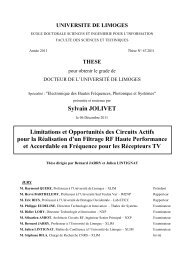Contribution à la conception optimale en terme de linéarité et ...
Contribution à la conception optimale en terme de linéarité et ...
Contribution à la conception optimale en terme de linéarité et ...
Create successful ePaper yourself
Turn your PDF publications into a flip-book with our unique Google optimized e-Paper software.
Figure II.3 – Facteur <strong>de</strong> <strong>linéarité</strong> IP3, C/I3................................................................................ 49<br />
Figure II.4 – D<strong>en</strong>sité spectrale <strong>de</strong> puissance du bruit d’intermodu<strong>la</strong>tion................................. 53<br />
Figure II.5 – Comparaison / I t<br />
C 3 e ( / I)<br />
∞<br />
C ........................................................................... 55<br />
Figure II.6 – excitation d’un système non linéaire................................................................... 55<br />
Figure II.7 - Structure <strong>de</strong> donnée usuelle ................................................................................ 56<br />
Figure II.8 – DSP <strong>et</strong> corré<strong>la</strong>tion d’un bruit pseudo-b<strong>la</strong>nc ........................................................ 57<br />
Figure II.9 – Transformé spectrale <strong>de</strong> puissance <strong>et</strong> <strong>de</strong> phase du signal X(t)............................ 58<br />
Figure II.10 – D<strong>en</strong>sité spectrale du signal d’<strong>en</strong>trée.................................................................. 60<br />
Figure II.11 – D<strong>en</strong>sité <strong>de</strong> probabilité d’un signal composé <strong>de</strong> 100 porteuses ......................... 61<br />
Figure II.12 – Construction d’une répartition spectrale <strong>de</strong> porteuse........................................ 62<br />
Figure II.13 – Spectres <strong>de</strong>s signaux d’<strong>en</strong>trée <strong>et</strong> <strong>de</strong> sortie d’un amplificateur .......................... 63<br />
Figure II.14 – Calcul <strong>de</strong>s puissances........................................................................................ 64<br />
Figure II.15 – Influ<strong>en</strong>ce du notch............................................................................................. 65<br />
Figure II.16 – Influ<strong>en</strong>ce du nombre <strong>de</strong> porteuse ...................................................................... 65<br />
Figure II.17 – Influ<strong>en</strong>ce du tirage <strong>de</strong> phase.............................................................................. 66<br />
Figure II.18 – Influ<strong>en</strong>ce du nombre <strong>de</strong> porteuse sur <strong>la</strong> variance.............................................. 68<br />
Figure II.19 - Moy<strong>en</strong>ne spectrale (10 réalisations) .................................................................. 69<br />
Figure II.20 – Différ<strong>en</strong>tes moy<strong>en</strong>nes pour le calcul du NPR (100 porteuses) ......................... 70<br />
Figure II.21 – Evolution <strong>de</strong> <strong>la</strong> variance.................................................................................... 71<br />
Figure II.22 – Distribution du bruit d’intemodu<strong>la</strong>tion ............................................................. 72<br />
Figure II.23 – Caractéristique AM/AM <strong>et</strong> AM/PM d’un amplificateur................................... 74<br />
Figure II.24 – métho<strong>de</strong> par intercorré<strong>la</strong>tion (comparaison) ..................................................... 75<br />
Figure II.25 – Facteur <strong>de</strong> forme ............................................................................................... 76<br />
Figure II.26 – Variance du NPR pour un signal <strong>à</strong> 100 porteuses............................................. 77<br />
Figure II.27 – validation <strong>de</strong> <strong>la</strong> méthodologie ........................................................................... 81<br />
Figure III.1 – Chaîne <strong>de</strong> transmission multiporteuse par satellite............................................ 88<br />
Figure III.2 –Schéma simplifié d’une liaison par satellite ....................................................... 89<br />
Figure III.3 – Loi d’échelle Linéaire........................................................................................ 92<br />
Figure III.4 – Bi<strong>la</strong>n <strong>de</strong> liaison .................................................................................................. 93<br />
Figure III.5 – Schéma équival<strong>en</strong>t non-linéaire d’un transistor <strong>à</strong> eff<strong>et</strong> <strong>de</strong> champ ..................... 93<br />
Figure III.6 – Contours <strong>à</strong> puissance <strong>de</strong> sortie constante (Ps=120 mW, Zout(f0)).................... 96<br />
Figure III.7 - Contours <strong>à</strong> puissance <strong>de</strong> sortie constante (Ps=120 mW, Zout(2f0)) .................. 96<br />
Figure III.8 - Contours <strong>à</strong> puissance <strong>de</strong> sortie constante (Ps=120 mW, Zin(f0)) ...................... 98
















